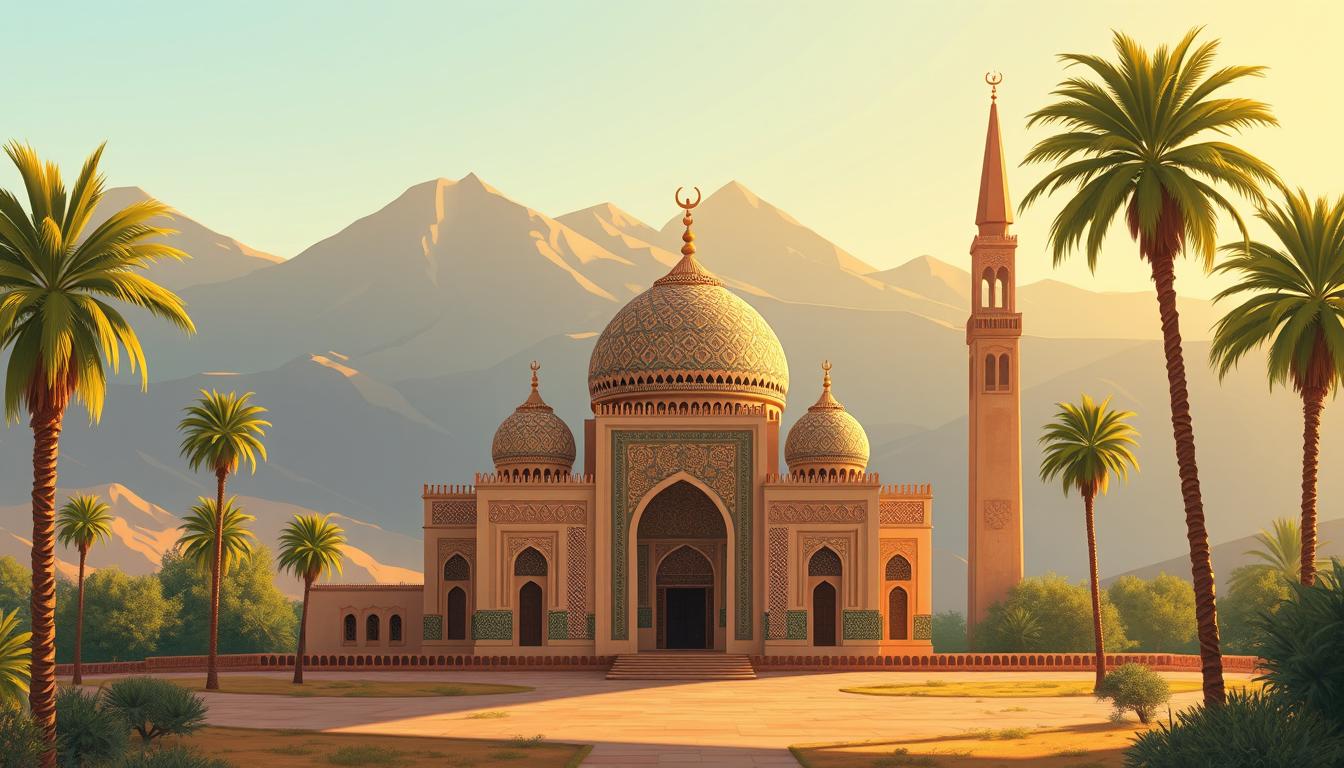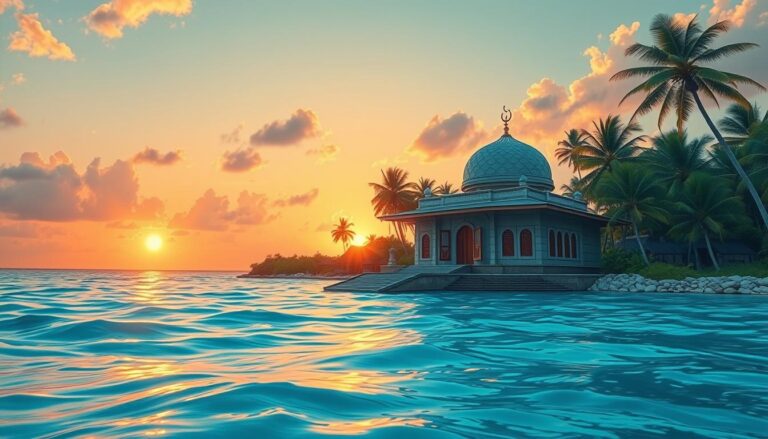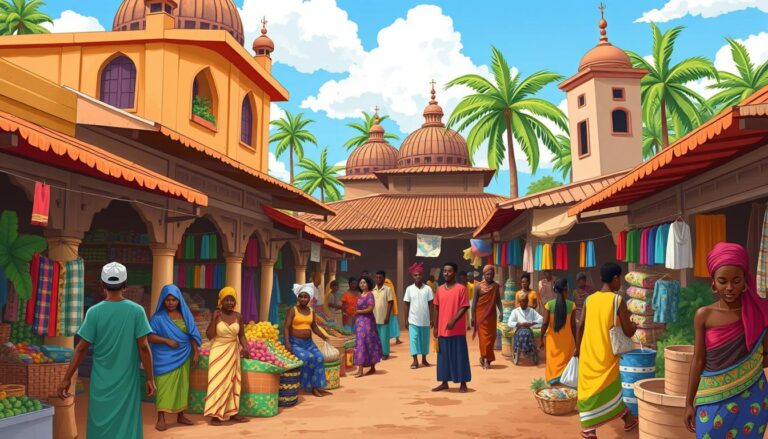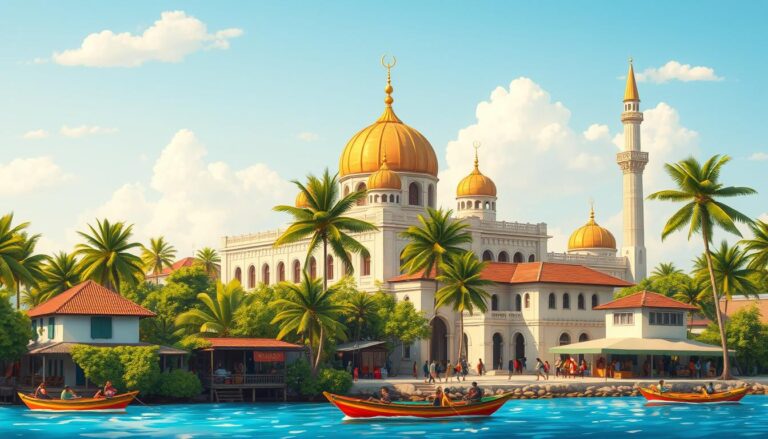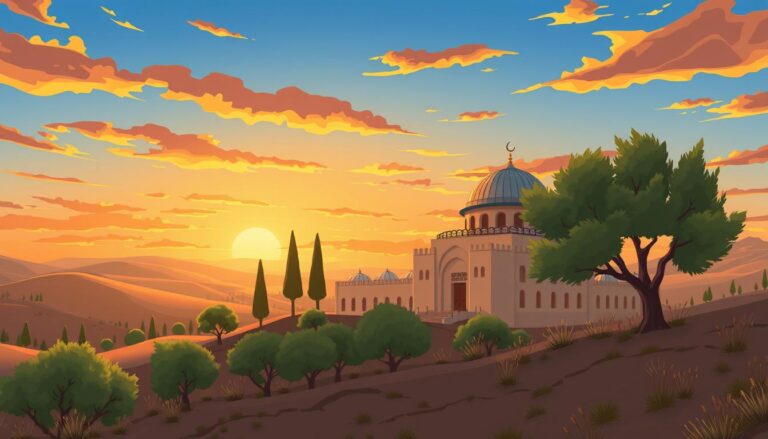Islam in Morocco
The constitution says Islam is the state’s religion in Morocco. It also protects freedom of thought, expression, and assembly. Almost all people, over 99%, follow Sunni Islam, mainly the Maliki madhab.
The King is called the “Commander of the Faithful.” He protects Islam and ensures everyone can practice their religion freely. Islam came to Morocco in 681 A.D. with the Arab invasion led by Uqba ibn Nafi.
Over the years, dynasties like the Idrisids, Almoravids, and Almohads ruled Morocco. They greatly influenced its religious and cultural landscape.
Islam in Morocco: An Overview
Islam is the official religion of Morocco. The country’s constitution protects freedom of thought and assembly. Over 99% of people are Sunni Muslims, mainly following the Maliki school of thought.
The constitution also says the King is the “Commander of the Faithful.” He protects Islam and ensures everyone can practice their religion freely.
Constitutional Status and Demographics
The Sunni Islam in Morocco makes up more than 99% of the population. The Maliki school of Islam has been key since the 11th century. Shia, Quranism, and Ibadism make up less than 1% of Muslims.
Sunni Islam and the Maliki School
The Moroccan Islam is mostly Sunni and Maliki. The government supports the Maliki school, with over 100,000 imams promoting it. But, there are also Salafi and Quranist groups.
“Morocco has a rich history of being a leading center for religious discourse and education throughout the Islamic world.”
Morocco’s Islamic learning and scholarship have shaped its religious scene. Places like Al-Qaraouiyine University are key. The rulers have mixed politics and theology to strengthen their power.
Historical Roots of Islam in Morocco
The story of Islam in Morocco goes back centuries. It arrived and spread, deeply changing the country’s culture and faith. The history of Islam in Morocco started in the 8th century.
Arrival and Spread of Islam
In 681 A.D., Arabs, led by Uqba ibn Nafi, invaded Morocco. They were under the Umayyad Caliphate. This event marked the beginning of Islam in Morocco.
Over time, Islam grew fast in Morocco. The area became a key part of the Muslim world.
The Idrisid Dynasty and Sufi Influences
In 788, the Shia Idrisids took power. They ruled big parts of Morocco. They were known for their support of Sufism, a mystical part of Islam.
The Idrisid dynasty had a big impact on Morocco’s faith and culture. Their legacy still shapes the country today.
People still visit the shrines of the Idrisid founders. This shows how Sufism in Morocco remains important.
“The Idrisids were known for their promotion of Sufism and were held in high esteem as effective rulers and pious Muslims.”
The Maliki School and Moroccan Jurisprudence
The Maliki school has been key in Moroccan religious life for centuries. It was founded by Malik ibn Anas in the 8th century. It became popular in North Africa, West Africa, and Iberia during the Almoravid dynasty (1040-1147).
In Morocco, the Maliki school’s appeal lies in its respect for political leaders. It also avoids mixing religion with politics. This made it appealing to many leaders in the country.
Today, the Maliki school is one of the four major Sunni Islam schools. It’s as big as the Shafi’i madhhab but smaller than the Hanafi madhhab. Sharia based on Maliki Fiqh is found in North Africa, West Africa, and parts of the Middle East.
The Muwatta Imam Malik and the Al-Mudawwana are key texts for the Maliki school. It bases its teachings on the Quran, Hadiths, and the customs of Medina. It also considers the opinions of the Sahabah, Qiyas, Islah, and Urf.
The Maliki school has greatly influenced Morocco. It has shaped the country’s Islamic laws and contributed to “Moroccan Islam.” This legacy remains a big part of Morocco’s religious and cultural identity.
“The Maliki school’s popularity was due, in part, to the deference it gave to established political authorities and its general reluctance to infuse religion with politics.”
Dynasties and Theological Movements
Morocco’s Islamic heritage is rich and varied. It has been influenced by many dynasties. The Almoravid and Almohad dynasties, for example, left lasting impacts on the region’s theology.
The Almoravids and Maliki Jurisprudence
The Almoravid dynasty made Maliki jurisprudence the top choice in Morocco. This school values tradition and community consensus. During their rule, Maliki scholarship thrived, spreading its influence widely.
The Almohads and Zahiri Theology
The Almohad Dynasty followed, led by Abu Abd Allah Muhammad Ibn Tumart. He promoted Zahiri theology, which opposed Maliki jurisprudence. Zahiri sought a simpler, more literal Quran interpretation, rejecting complex theological ideas.
These movements and dynasties have deeply influenced Moroccan Islam. They have shaped its identity and continue to evolve its religious traditions.
“The Almoravid and Almohad dynasties played a pivotal role in shaping the theological landscape of Morocco, with the Almoravids championing the Maliki school of jurisprudence and the Almohads promoting the Zahiri theology.”
Sufi Orders and Shrines in Morocco
Morocco is deeply rooted in Sufism. It has a rich tapestry of Sufi orders and shrines. These places are centers of prayer, devotion, and learning, keeping the country’s spiritual heritage alive for centuries.
Significance of Sufi Traditions
Sufi traditions and the veneration of Sufi saints are key parts of Moroccan Islamic culture since the 8th century. Marrakech, for example, was a major trading spot and rest stop north of the Sahara. It was where merchants and pilgrims shared their ideas and religious practices, including Sufism in Morocco.
Today, Morocco is filled with notable Sufi shrines and Sufi orders. Each has its own history and importance. Places like the Zawiya Naciria in Tamagroute, Zagora, and the holiest fortress of Idriss Zerhoun are popular pilgrimage sites. They continue to attract visitors from all over.
“Sufism played a major role in fostering tolerance in Morocco, becoming an attractive tradition for the youth.”
The impact of Sufism in Morocco goes beyond its spiritual value. Sufi orders have been key in social mediation, community building, and economic growth. They offer medical care, spiritual teachings, and volunteer work to support their communities.
As Morocco faces challenges like youth unemployment and extremism, Sufism’s presence is more important than ever. It offers a moderate and inclusive path forward.
Islamic Architecture and Art in Morocco
Morocco’s Islamic heritage shines through in its stunning architecture and art. The country boasts many mosques, shrines, and religious buildings. These structures reflect the impact of Islamic dynasties and their distinct styles. The Hassan II Mosque in Casablanca and the detailed tilework and calligraphy across Morocco are celebrated for their beauty and skill.
The architectural journey in Morocco spanned nearly six centuries, from the 11th to the 17th century. Dynasties like the Almoravids and Almohads left their mark on the country’s buildings. The Almoravid style, for example, featured Moorish arches and decorations.
The Almohad dynasty was influenced by Andalusia, leading to a significant artistic movement. This period was marked by grand mosques and impressive minarets. The Marinades period (1278-1358) was a golden age, with sultans like Abu el-Hassan and Abu Inan building mosques and madrasas.
Some top examples of Islamic architecture in Morocco are the Hassan II Mosque in Casablanca, the Koutoubia Mosque in Marrakesh, and the Grand Mosque in Chefchaouen. These buildings highlight the varied architectural styles that have enriched Morocco’s culture.
Morocco is also famous for its lively Moroccan Islamic art. The intricate tilework, calligraphy in religious sites, and captivating textiles and metalwork show the country’s deep Islamic roots.
“Morocco’s Islamic architecture and art are a testament to the country’s rich cultural heritage, blending influences from various dynasties and traditions to create a truly unique and breathtaking aesthetic.”
Contemporary Islam in Morocco
Modern Islam in Morocco has seen big changes in recent years. After the al-Qaeda bombings in Casablanca in 2003, the government made a big plan to stop Islamist extremism.
Government Efforts to Combat Extremism
The Moroccan government is working hard to fight extremism. They are doing this through many ways, like security, politics, economy, and religion. They watch what is said in mosques, change how Islamic education is taught, and push for a “Moroccan Islam” that fights radicalism.
Religious Education and Reforms
The government wants Morocco to be a top place for Islamic learning. They are changing the way religious education is done. The goal is to teach a tolerant, inclusive, and modern Islam in Morocco.
These steps are part of the government’s big plan to fight religious extremism. They want to make Morocco known as a place of moderate Islam. By improving religious education reform, they hope to keep people away from extremist ideas. They also want to make Morocco a key place for Islamic studies and scholarship.
“The Moroccan government’s comprehensive approach to combating extremism, including religious education reform, reflects its commitment to promoting a tolerant and inclusive vision of Islam in Morocco.”
Minority Muslim Sects in Morocco
In Morocco, Sunni Maliki Islam is the main form of Islam. But, the country also has smaller Muslim groups. These include Shia Muslims, Ahmadis, and Quranists, each with a few thousand followers. Despite laws protecting religious freedom, these groups often keep their faith private due to societal pressures and discrimination.
The Shia Muslim community in Morocco is small but present, especially in the north. There are thousands of Shia citizens and around 1,000 to 2,000 foreign Shia residents. The Ahmadi Muslim community has about 750 members in Morocco.
Quranists, who follow the Quran alone, also exist in Morocco. They have 1,000 to 2,000 followers. These groups, recognized by the Moroccan constitution, still face challenges in openly practicing their faith. This is due to societal attitudes and discrimination.
“The presence of these minority Muslim sects in Morocco underscores the diversity within the country’s Islamic landscape, despite the dominance of Sunni Maliki Islam.”
The Moroccan government tries to promote religious tolerance and fight extremism. But, the experiences of these minority Muslim groups show the need to protect religious freedoms. They also highlight the importance of integrating all citizens, no matter their faith.
Conclusion
Morocco’s history is deeply tied to Islam for centuries. The Maliki school of Sunni Islam is the main faith in the country. The monarchy’s power comes from protecting Islam.
King Mohammed VI wants to show a “Moroccan Islam” that’s different from extremism. The government works hard to fight radicalism and be a center for Islamic learning. This is something to be proud of.
But, Morocco also has to deal with different religious views and minority Muslim groups. The Alaouite dynasty has ruled since 1631. After the 2003 terrorist attacks, there was a crackdown on Salafi Islamists.
The Justice and Development Party (PJD) won big in 2011 but lost most of its seats in 2021. Despite these ups and downs, Morocco remains a key place for Islamic learning and moderation.
“Morocco has a rich and complex history of Islamic influence, with the Maliki school of Sunni Islam serving as the dominant form of the faith for centuries.”
Sidebar: Significance of Sufi Traditions in Morocco
Sufism, a mystical part of Islam, has deeply influenced Morocco for centuries. The country is filled with Sufi shrines and zawiyat (Sufi lodges). These places are centers for prayer, learning, and devotion.
Sufi orders like the Tijaniyya started in Morocco and now affect Islam worldwide. This shows the wide reach of Sufism in Morocco.
In Morocco, Sufi saints are highly respected. Their practices are woven into daily life. This makes Morocco known for its religious pluralism and tolerance.
Every summer, thousands visit Moulay Driss Zerhoun in central Morocco. They honor a Sufi saint buried there 12 centuries ago. The “moussem” lasts over a month, bringing pilgrims to the town of 12,000.
Morocco aims to protect a balanced Islam, free from extremism. The visit to Moulay Driss Zerhoun supports this goal. It also boosts the local economy by drawing in tourists.
“70% of Moroccan respondents trust or completely trust King Mohammed VI on religious matters, and 48% selected him as their approved religious leader.”
A survey shows Moroccans trust the King a lot on religious issues. This highlights the role of Sufi shrines and orders in Morocco’s Moroccan Sufi culture.
Sidebar: The Contested Nature of “Moroccan Islam”
The Moroccan government wants to show a unique and calm “Moroccan Islam” to fight extremism. But, this goal is still being worked on and has its challenges. Inside Morocco, there are different kinds of religious and political disagreements.
Groups like Salafists disagree with the government’s view of “Moroccan Islam.” They say the government’s push for religion is just for power and is too strict.
The Moroccan people are still deciding if they agree with the monarchy’s religious ideas. Morocco’s religious scene is changing and has many different views. This shows the hard work of balancing the state’s control over religion with the people’s beliefs and the need for modern changes.
Even with the government’s efforts, “Moroccan Islam” is still evolving. The country’s religious identity and how the state fits into it are topics of ongoing debate. Different religious and political groups in Morocco have their own views on this.
Source Links
- How Morocco’s king dealt a blow to political Islam
- Religion in Morocco: Islam and other faiths | Chic Morocco
- Islam in Morocco
- Educator of the Faithful: The Power of Moroccan Islam
- Morocco – United States Department of State
- Morocco: The Coming of Islam
- Bridging Cultures Bookshelf: Muslim Journeys
- History of Morocco
- Morocco’s Political Use of Islam and its Religious Diplomacy
- Maliki school
- Islamism, Moroccan-Style: The Ideas of Sheikh Yassine
- Religion, Authoritarianism, and Electoral Politics — Markus Wiener Publishers
- 8 Sacred Sites For Hidden Secrets of Sufi – Morocco Classic Tours
- Sufism in Morocco: A cure for extremism? | Qantara.de
- Sufism in Morocco, a bridge to the future
- Islamic Architecture in Morocco, Your Morocco Travel Guide |
- From Islamic to Art Deco: A rich history of Moroccan architecture
- Islam on the Edges EP4 – Islamic Thought in Morocco: Philosophy and Muslim Feminism – Maydan
- Morocco as a Hub of Globalised Traditional Islam
- Islam in Morocco – History of Religion
- Religion in Morocco
- Morocco – United States Department of State
- Islamism and the State in Morocco
- Morocco – United States Department of State
- The end of the Moroccan “model”: How Islamists lost despite winning
- Morocco’s Visitation of the Poor honors Sufi Muslim Saint
- Public Opinion on the Religious Authority of the Moroccan King | Baker Institute
- No title found
- Past Events
- No title found
- 34782-how_57-3

